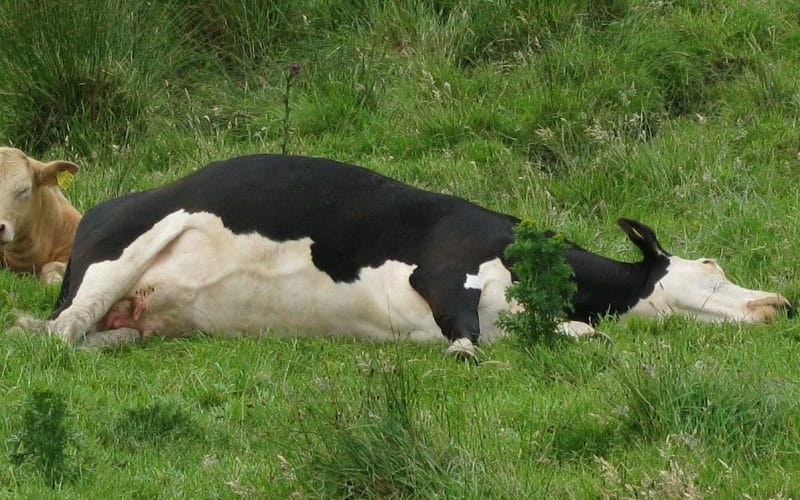Overview
Bloat (ruminal tympany) is a condition characterized by the excessive accumulation of gas in the rumen, leading to distension and potential respiratory distress. It is classified into two types:
Primary (Frothy) Bloat: Gas is trapped in a stable foam, often associated with diets high in legumes or finely ground grains (Merck Veterinary Manual, Bivatec)
Secondary (Free-Gas) Bloat: Gas accumulates due to physical obstruction or impaired eructation mechanisms (NRCS, Vetscraft).


Frothy Bloat in Cattle
Classic Presentation
- Acute abdominal distention, primarily on the left side
- Tachycardia
- Open-mouthed breathing
- Frothy, green, stable rumen ingesta:
- Foam with tiny, persistent bubbles that do not pop
- Inability to eructate (belch) → trapped gas
- May be found acutely dead with left-sided distention
Etiology / Risk Factors
- Pasture-associated bloat:
- Cows recently introduced to legume pastures (within last 2 weeks)
- Common legumes: alfalfa, clover
- Feedlot bloat:
- Exact cause unclear
- Possible factors:
- Slime-producing rumen bacteria
- Finely ground, highly fermentable feed particles
- Free gas bloat (differential):
- Due to obstruction of normal eructation pathway (e.g., choke, positional changes)
Diagnosis
- Visual Observation:
- Obvious bloating—distention more on left flank
- Differentiate Frothy vs. Free Gas Bloat:
- Pass a stomach tube:
- Frothy Bloat:
- Small amount of frothy green rumen contents oozes out
- No significant gas release or relief
- Free Gas Bloat:
- Large volume of gas released
- Immediate relief of distention
- Frothy Bloat:
- Pass a stomach tube:
Treatment
Mild / Early Cases
- Antifoaming Agents:
- Vegetable or mineral oil: 250–500 mL
- Dioctyl sodium sulfosuccinate (DSS): often combined with oil
- Poloxalene:
- Effective for pasture (legume) bloat
- Not effective for feedlot bloat
Severe / Life-Threatening Cases
- Emergency Procedures:
- Rumenotomy (surgical intervention)
- Large-bore trocar or rumen cannula (2.5 cm diameter)
- Allows gas release over hours
- Administer antifoaming agents through the trocar or cannula
Key Points
Prognosis
- Good if recognized and treated early
- Poor outcome if animal found dead or if respiratory distress is prolonged
Prevention
- Pasture (Legume) Bloat:
- Ionophores (e.g., monensin, lasalocid)
- Gradual introduction to lush pastures
- Feed hay before pasture access to limit sudden fermentation
- Feedlot Bloat:
- Incorporate 10–15% coarse-chopped roughage into the diet
- Use ionophores (e.g., lasalocid) as feed additives
Causes
Primary Bloat: Ingestion of lush legume pastures (e.g., alfalfa, clover), high-concentrate diets, or finely ground grains (Nebraska Extension, Ag & Natural Resources College)
Secondary Bloat: Esophageal obstruction (choke), hypocalcemia, vagal indigestion (PMC, Merck Veterinary Manual)
Clinical Signs
- Distension of the left paralumbar fossa (Ag & Natural Resources College)
- Discomfort, restlessness, vocalization (Bivatec)
- Dyspnea and open-mouth breathing
- Sudden death in severe cases (Wikipedia)
Diagnosis
- Clinical examination revealing ruminal distension
- Passing a stomach tube to differentiate between frothy and free-gas bloat (Merck Veterinary Manual)
Treatment
Frothy Bloat: Administration of antifoaming agents such as poloxalene via stomach tube (The Cattle Site)
Free-Gas Bloat: Relief via stomach tube or trocarization in emergencies (Bovine Veterinarian)
Emergency rumenotomy may be required in severe cases (Merck Veterinary Manual)
Prevention
- Gradual introduction to high-risk pastures
- Feeding dry hay before turnout
- Use of bloat-preventive feed additives (Nebraska Extension)
Choke in Cattle
Overview
Choke is esophageal obstruction caused by the ingestion of large food items or foreign bodies. It is a veterinary emergency due to the high risk of secondary bloat (CowDVM)
Causes
- Ingestion of large root vegetables, fruits, or poorly chewed feed
- Foreign bodies such as plastic, cloth (Merck Veterinary Manual)
Clinical Signs
- Excessive salivation and coughing (CowDVM)
- Repeated attempts to swallow (Texas Parks & Wildlife)
- Distension of the left paralumbar fossa due to secondary bloat (Ag & Natural Resources College)
Diagnosis
- History and clinical signs (CowDVM)
- Palpation of the esophagus
- Endoscopy or radiography if available (Merck Veterinary Manual)
Treatment
- Sedation and manual removal if the object is palpable
- Use of a stomach tube or probang to dislodge the obstruction (The Cattle Site)
- Surgical intervention (esophagotomy) in refractory cases
Prevention
- Proper feed processing to avoid large particles
- Avoid feeding large root vegetables or fruits whole
NAVLE-Style Multiple-Choice Questions
Question 1: Diagnosis
Clinical Scenario:
A 3-year-old beef cow presents with sudden onset of left-sided abdominal distension, discomfort, and dyspnea after grazing on lush clover pasture.
Question:
What is the most likely diagnosis?
A. Traumatic reticuloperitonitis
B. Primary (frothy) bloat
C. Secondary (free-gas) bloat
D. Choke
E. Left displaced abomasum
Correct Answer: B. Primary (frothy) bloat
Explanation: The sudden onset after grazing on legume-rich pasture suggests frothy bloat, characterized by stable foam formation in the rumen. (Bovine Veterinarian, Wikipedia)
Question 2: Treatment
Clinical Scenario:
A cow exhibits signs of bloat. A stomach tube is passed, and gas is released, relieving the distension.

Question:
What type of bloat is most consistent with this response?
A. Primary (frothy) bloat
B. Secondary (free-gas) bloat
C. Vagal indigestion
D. Choke
E. Abomasal impaction
Correct Answer: B. Secondary (free-gas) bloat
Explanation: Relief of bloat by stomach tube indicates free-gas bloat, where gas accumulates due to impaired eructation (Merck Veterinary Manual)
Question 3: Complication
Clinical Scenario:
A cow with esophageal obstruction is not treated promptly.
Question:
What is the most likely life-threatening complication?
A. Aspiration pneumonia
B. Secondary (free-gas) bloat
C. Esophageal stricture
D. Ruminal acidosis
E. Peritonitis
Correct Answer: B. Secondary (free-gas) bloat
Explanation: Esophageal obstruction prevents eructation, leading to gas accumulation and potentially fatal ruminal tympany (Merck Veterinary Manual)